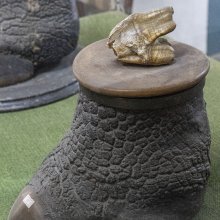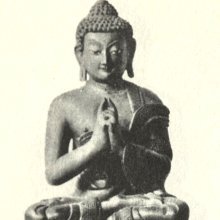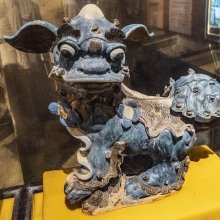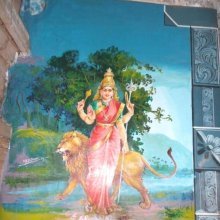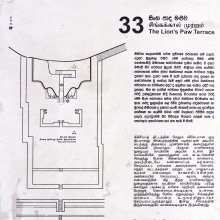Simha, Siṃha: 42 definitions
Introduction:
Simha means something in Buddhism, Pali, Hinduism, Sanskrit, Jainism, Prakrit, Marathi, Hindi. If you want to know the exact meaning, history, etymology or English translation of this term then check out the descriptions on this page. Add your comment or reference to a book if you want to contribute to this summary article.
Images (photo gallery)
(+8 more images available)
In Hinduism
Ayurveda (science of life)
Veterinary Medicine (The study and treatment of Animals)
Source: Shodhganga: Portrayal of Animal Kingdom (Tiryaks) in Epics An Analytical studySiṃha (सिंह) (lit. “one who is the best in the group”) refers to the Lion (Panthera Leo Persica), according to scientific texts such as the Mṛgapakṣiśāstra (Mriga-pakshi-shastra) or “the ancient Indian science of animals and birds” by Hamsadeva, containing the varieties and descriptions of the animals and birds seen in the Sanskrit Epics such as the Ramayana and Mahabharata.
Toxicology (Study and Treatment of poison)
Source: Shodhganga: Kasyapa Samhita—Text on Visha ChikitsaSiṃha (सिंह) refers to one of the sixteen varieties of “rats” (Ākhu or Mūṣika), according to the Kāśyapa Saṃhitā: an ancient Sanskrit text from the Pāñcarātra tradition dealing with both Tantra and Viṣacikitsā—an important topic from Āyurveda which deals with the study of Toxicology (Viṣavidyā or Sarpavidyā).—The Kāśyapasaṃhitā seems to consider rat poison as the next powerful one, seriously affecting human beings. Kāśyapa gives antidotes for the 16 varieties of rats (e.g., Siṃha). The author follows this up with certain general instructions in tackling poisons.
Symptoms of Siṃha: Tastelessness, fever, fatigue, burning sensation, cold, horripilation, downward movements.
Treatment (Antidote) of Siṃha: A drink made out of a measure of powdered roots of Śirīṣa and Sumana blended with cow’s milk. Gruel of powdered root of Palāśa and milk to be administered as a drink and ointment. A measure of Palaśa roots must be used for fumigation.
Unclassified Ayurveda definitions
Source: Wisdom Library: Āyurveda and botanySiṃha (सिंह) is a Sanskrit word referring to the animal “lion”. The meat of this animal is part of the māṃsavarga (‘group of flesh’), which is used throughout Ayurvedic literature. The animal Siṃha is part of the sub-group named prasaha, refering to animals “who take their food by snatching”. It was classified by Caraka in his Carakasaṃhitā sūtrasthāna (chapter 27), a classical Ayurvedic work. Caraka defined such groups (vargas) based on the dietic properties of the substance.
Source: archive.org: Sushruta samhita, Volume ISiṃha (सिंह)—Sanskrit word for the animal “lion”. This animal is from the group called Guhāśaya (‘which have a lair’, or, ‘cave-dwelling mammals’). Guhāśaya itself is a sub-group of the group of animals known as Jāṅghala (living in high ground and in a jungle).
Source: gurumukhi.ru: Ayurveda glossary of termsSiṃha (सिंह):—Lion.

Āyurveda (आयुर्वेद, ayurveda) is a branch of Indian science dealing with medicine, herbalism, taxology, anatomy, surgery, alchemy and related topics. Traditional practice of Āyurveda in ancient India dates back to at least the first millenium BC. Literature is commonly written in Sanskrit using various poetic metres.
Vastushastra (architecture)
Source: Wisdom Library: Vāstu-śāstra1) Siṃha (सिंह):—The Sanskrit name for a classification of a ‘temple’, according to the 2nd century Matsyapurāṇa and the Viśvakarmaprakāśa, both featuring a list of 20 temple types. This list represents the classification of temples in South-India.
Siṃha is mentioned in another list from the Samarāṅgaṇasūtradhāra chapter 56, being part of the group named Lalita, containing 25 unique temple varieties.
2) Siṃhā (सिंहा, “lioness”) refers to the third of eight yoni (womb), according to the Mānasāra. Yoni is the fourth of the āyādiṣaḍvarga, or “six principles” that constitute the “horoscope” of an architectural or iconographic object. Their application is intended to “verify” the measurements of the architectural and iconographic object against the dictates of astrology that lay out the conditions of auspiciousness.
Siṃhā also refers to the fifth of twelve rāśi (zodiacal sign), corresponding with the Leo zodiac sign. Rāśi is one of the three alternative principles, besides the six āyādiṣaḍvarga.
The particular yoni (e.g., siṃhā) and rāśi (e.g., siṃha) of all architectural and iconographic objects (settlement, building, image) must be calculated and ascertained. This process is based on the principle of the remainder. An arithmetical formula to be used in each case is stipulated, which engages one of the basic dimensions of the object (breadth, length, or perimeter/circumference).
The first, third, fifth and seventh yonis are considered auspicious and therefore to be preferred, and the rest, inauspicious and to be avoided. All twelve rāśis, except the eighth (vṛścika) are auspicious.
Source: Wisdom Library: Vāstu-śāstraSiṃha (सिंह) refers to a variety of maṇḍapa (halls attached to the temple), according to the Matsya-purāṇa (verses 270.1-30). The siṃha-maṇḍapa is to be built with 16 pillars (stambha). The Matsyapurāṇa is one of the eighteen major purāṇas dating from the 1st-millennium BCE.
Accordingly (verse 270.15-17), “These maṇḍapas (e.g., siṃha) should be either made triangular, circular, octagonal or with 16 sides or they are square. They promote kingdoms, victory, longevity, sons, wife and nourishment respecitvely. Temples of other shape than these are inauspicious.”
Source: Shodhganga: Elements of Art and Architecture in the Trtiyakhanda of the Visnudharmottarapurana (vastu)Siṃha (सिंह) refers to one of the hundred types of Temples (in ancient Indian architecture), according to the Viṣṇudharmottarapurāṇa, an ancient Sanskrit text which (being encyclopedic in nature) deals with a variety of cultural topics such as arts, architecture, music, grammar and astronomy.—It is quite difficult to say about a definite number of varieties of Hindu temples but in the Viṣṇudharmottarapurāṇa hundred varieties of temples have been enumerated. For example, Siṃha. These temples are classified according to the particular shape, amount of storeys and other common elements, such as the number of pavilions, doors and roofs. [...] The Viṣṇudharmottarapurāṇa relates that the temple named Siṃha should be constructed in the shape of a lion.

Vastushastra (वास्तुशास्त्र, vāstuśāstra) refers to the ancient Indian science (shastra) of architecture (vastu), dealing with topics such architecture, sculpture, town-building, fort building and various other constructions. Vastu also deals with the philosophy of the architectural relation with the cosmic universe.
Purana and Itihasa (epic history)
Source: archive.org: Shiva Purana - English TranslationSiṃha (सिंह) refers to a Lion (representing one of the beasts of prey—hiṃsra), according to the Śivapurāṇa 2.5.2 (“The Prayer of the gods).—Accordingly, as the Gods eulogized Śiva: “[...] Among all stones, you are the crystal, O great god, among the flowers you are the lotus; among mountains you are Himavat. Among all activities you are the speech; among poets you are Bhārgava. Among birds you are the eight-legged Śarabha. Among beasts of prey you are the lion (siṃha). [...]”.
Source: Cologne Digital Sanskrit Dictionaries: The Purana Index1a) Siṃha (सिंह).—A son of Mādrī and Kṛṣṇa.*
- * Bhāgavata-purāṇa X. 61. 15.
1b) A palace in the form of a lion; the toraṇa is 16 hastas.*
- * Matsya-purāṇa 269. 36, 49.
1c) Born of Hari and Pulaha; as a son of Jāmbavān, a vānara jāti;1 a golden image of, as a gift for vīravrata of women;2 the riding animal of Lalitā;3 born out of the wrath of Śiva and destroyed Dakṣa's sacrifice.4
- 1) Brahmāṇḍa-purāṇa III. 7. 176, 304, 319; 22. 19; 26. 30; IV. 6. 50.
- 2) Matsya-purāṇa 101. 28.
- 3) Brahmāṇḍa-purāṇa III. 35. 38; 51. 10; IV. 17. 8; 29. 41.
- 4) Vāyu-purāṇa 101. 295.
Siṃha (सिंह) is a name mentioned in the Mahābhārata (cf. I.60.7) and represents one of the many proper names used for people and places. Note: The Mahābhārata (mentioning Siṃha) is a Sanskrit epic poem consisting of 100,000 ślokas (metrical verses) and is over 2000 years old.
Source: valmikiramayan.net: Srimad Valmiki RamayanaSiṃha (सिंह) refers to “lions” (residing in mountain caves), according to the Rāmāyaṇa verse 2.28.7. Accordingly:—“[...] soothening with kind words to Sītā, when eyes were blemished with tears, the virtuous Rāma spoke again as follows, for the purpose of waking her turn back: ‘[...] the sounds created from waterfalls in hills and from lions (siṃha) residing in mountain caves (girikandara) are unpleasant to hear. That is why living in a forest in uncomfortable’”.
In reply, regarding lions (siṃha) in the forest, Sītā said to Rāma in the Rāmāyaṇa chapter 2.29. Accordingly:—“[...] Sītā was distressed to hear these words of Rāma and spoke these words slowly, with her face with tears: ‘[...] Oh Rāma! Antelopes, lions (siṃha), elephants, tigers, Śarabhas (legendary animal with eight legs), birds, yaks and all others which roam in the forest, run away after seeing your form, since they have never seen your figure before. When there is cause for fear, who would not have fear?’”.

The Purana (पुराण, purāṇas) refers to Sanskrit literature preserving ancient India’s vast cultural history, including historical legends, religious ceremonies, various arts and sciences. The eighteen mahapuranas total over 400,000 shlokas (metrical couplets) and date to at least several centuries BCE.
Kavya (poetry)
Source: Wisdom Library: KathāsaritsāgaraSiṃha (सिंह) is the name of a Vidyādhara king, according to the Kathāsaritsāgara, chapter 106. Accordingly, as Dhanavatī said to prince Naravāhanadatta: “... prince, I am Dhanavatī, the wife of a chief of the Vidyādharas, named Siṃha, and this is my unmarried daughter, the sister of Caṇḍasiṃha, and her name is Ajināvatī”.
The Kathāsaritsāgara (‘ocean of streams of story’), mentioning Siṃha, is a famous Sanskrit epic story revolving around prince Naravāhanadatta and his quest to become the emperor of the vidyādharas (celestial beings). The work is said to have been an adaptation of Guṇāḍhya’s Bṛhatkathā consisting of 100,000 verses, which in turn is part of a larger work containing 700,000 verses.

Kavya (काव्य, kavya) refers to Sanskrit poetry, a popular ancient Indian tradition of literature. There have been many Sanskrit poets over the ages, hailing from ancient India and beyond. This topic includes mahakavya, or ‘epic poetry’ and natya, or ‘dramatic poetry’.
Shilpashastra (iconography)
Source: Shodhganga: The significance of the mūla-beras (śilpa)Siṃha (सिंह, “lion”) refers to a type of animal form, representing one of the several “attributes” (āyudha) or “accessories” of a detiy commonly seen depicted in Hindu iconography, defined according to texts dealing with śilpa (arts and crafs), known as śilpaśāstras.—The śilpa texts have classified the various accessories under the broad heading of āyudha or karuvi (implement), including even flowers, animals, and musical instruments. The animals and birds found as vehicles for the deities or held as attributes or weapons in the hands of the deities are, for example, Siṃha.

Shilpashastra (शिल्पशास्त्र, śilpaśāstra) represents the ancient Indian science (shastra) of creative arts (shilpa) such as sculpture, iconography and painting. Closely related to Vastushastra (architecture), they often share the same literature.
Vaishnavism (Vaishava dharma)
Source: Pure Bhakti: Arcana-dipika - 3rd EditionSiṃha (सिंह) corresponds to “leo” (mid August to mid September) and refers to one of the zodiac signs (rāśī) in the Vedic calendar.—Rāśī refers to the different signs of the zodiac through which the sun travels. For precise dates, please refer to a Vedic calendar. In accordance with the zodiac sign the sun is situated in, one would utter [for example, siṃha-rāśī sthite bhāskare]

Vaishnava (वैष्णव, vaiṣṇava) or vaishnavism (vaiṣṇavism) represents a tradition of Hinduism worshipping Vishnu as the supreme Lord. Similar to the Shaktism and Shaivism traditions, Vaishnavism also developed as an individual movement, famous for its exposition of the dashavatara (‘ten avatars of Vishnu’).
Dharmashastra (religious law)
Source: Prācyā: Animals and animal products as reflected in Smṛti textsSiṃha (सिंह) refers to the animal “Lion” (Panthera leo persica).—The Smṛtis mention several domestic as well as wild animals that are enumerated in context of specifying expiation for killing them, the flesh being used as a dietary article to give satisfaction to the Manes (Pitṛs) in Śrāddha rites, the law of transmigration due to various sins committed as well as in the context of specifying gifts to be given on various occasions. These animals [viz., Siṃha] are chiefly mentioned in the Manusmṛti, Parāśarasmṛti [Chap.6], Gautamasmṛti [17.2 and 15.1], Śātātapasmṛti [II.45-54], Uśānasmṛti [IX.7-9; IX.12-13], Yājñavalkyasmṛti [I.170-171; I.175; I.258- 260], Viṣṇusmṛti [51.3;51.6;51.26;51.33;80.3-14], Uttarāṅgirasasmṛti [X.15-17], Prajāpatismṛti [Śrāddhatyājyavastuvarṇanam. 138-143], 9 Kāśyapasmṛti [Section on Prāyaścittavarṇanam], Vṛddha Hārītasmṛti [6.253-255] and Kātyāyanasmṛti [27.11].

Dharmashastra (धर्मशास्त्र, dharmaśāstra) contains the instructions (shastra) regarding religious conduct of livelihood (dharma), ceremonies, jurisprudence (study of law) and more. It is categorized as smriti, an important and authoritative selection of books dealing with the Hindu lifestyle.
Shaktism (Shakta philosophy)
Source: Google Books: ManthanabhairavatantramSiṃha (सिंह) is the name of the Youth (vaṭuka) associated with Oḍiyāna, one of the sacred seats (pīṭha), according to the Ṣaṭsāhasrasaṃhitā, an expansion of the Kubjikāmatatantra: the earliest popular and most authoritative Tantra of the Kubjikā cult.—On the basis of hardly more than a hint in the Ṣaṭsāhasrasaṃhitā, it outlines a scheme of sixteen parts for each seat, conscious, no doubt, that this is an ideal number. The commentary normally limits itself to do no more than explain what is presented in the text. This is one of the few instances it adds substantially to its contents [i.e., the Vaṭukas—Siṃha]. Presumably this is because when it was written the presentation of the features of the seats on this model was the accepted norm.

Shakta (शाक्त, śākta) or Shaktism (śāktism) represents a tradition of Hinduism where the Goddess (Devi) is revered and worshipped. Shakta literature includes a range of scriptures, including various Agamas and Tantras, although its roots may be traced back to the Vedas.
Jyotisha (astronomy and astrology)
Source: Wisdom Library: Brihat Samhita by Varahamihira1) Siṃha (सिंह) refers to the sign of Leo, according to the Bṛhatsaṃhitā (chapter 5), an encyclopedic Sanskrit work written by Varāhamihira mainly focusing on the science of ancient Indian astronomy astronomy (Jyotiṣa).—Accordingly, “If the sun and moon should begin to be eclipsed when only half risen, deceitful men will suffer as well as sacrificial rites. [...] If the sun and moon should be eclipsed when in the sign of Leo (Siṃha) hill men, prince like people possessed of a single military force, princes and forest men will suffer miseries. If they should be eclipsed when in the sign of Virgo (Kanyā), crops, poets, writers and singers will suffer and the rice fields of Aśmaka and Tripura will be destroyed”.
2) Siṃha (सिंह) (Cf. Hari) refers to “lions”, according to the Bṛhatsaṃhitā (chapter 5), an encyclopedic Sanskrit work written by Varāhamihira mainly focusing on the science of ancient Indian astronomy astronomy (Jyotiṣa).—Accordingly, “If the sun and moon should begin to be eclipsed when only half risen, deceitful men will suffer as well as sacrificial rites. [...] If they should be eclipsed when in the sign of Aquarius (Kumbha), hill men, men of western countries, carriers, robbers, shephards, serpents, worthy men, lions [i.e., siṃha], citizens and the people of Barbara will perish”.

Jyotisha (ज्योतिष, jyotiṣa or jyotish) refers to ‘astronomy’ or “Vedic astrology” and represents the fifth of the six Vedangas (additional sciences to be studied along with the Vedas). Jyotisha concerns itself with the study and prediction of the movements of celestial bodies, in order to calculate the auspicious time for rituals and ceremonies.
Shaivism (Shaiva philosophy)
Source: Brill: Śaivism and the Tantric TraditionsSiṃha (सिंह) refers to “lions”, according to the Guhyasūtra chapter 3.—Accordingly, “[...] One may perform the Block-of-Wood Observance in a forest full of bears, tigers and lions (siṃha), conquering the urges to sleep and eat, [constantly] reciting. If one takes on the appearance of a woman and sings and dances, adorned with bracelets, with a winnowing fan, ball and plait, one observes the Colourful Observance. With a weapon in hand, full of compassion, if one wanders like a saviour of creatures (?) focussed upon recitation, meditation and worship, one performs the Warrior Observance. [...]”.

Shaiva (शैव, śaiva) or Shaivism (śaivism) represents a tradition of Hinduism worshiping Shiva as the supreme being. Closely related to Shaktism, Shaiva literature includes a range of scriptures, including Tantras, while the root of this tradition may be traced back to the ancient Vedas.
Natyashastra (theatrics and dramaturgy)
Source: Shodhganga: Elements of Art and Architecture in the Trtiyakhanda of the Visnudharmottarapurana (natya)Siṃha (सिंह) or Siṃhagati refers to the “gait of the lion” and represents one of the various Gatis (“way of walking”) (in Indian Dramas), according to the Abhinayadarpaṇa.—Accordingly, gaits (gatis) are explained along with some particular hand gestures. It shows that footsteps are to be followed by some hand postures. In the gait of siṃha i.e., lion, the actor or dancer should stand on toes first and then jump forward speedily. The śikharahasta is adopted with both hands in this gait. Frog step is suggested to do exactly as the gait of siṃha in the Abhinayadarpaṇa.

Natyashastra (नाट्यशास्त्र, nāṭyaśāstra) refers to both the ancient Indian tradition (shastra) of performing arts, (natya—theatrics, drama, dance, music), as well as the name of a Sanskrit work dealing with these subjects. It also teaches the rules for composing Dramatic plays (nataka), construction and performance of Theater, and Poetic works (kavya).
Sports, Arts and Entertainment (wordly enjoyments)
Source: archive.org: Syainika Sastra of Rudradeva with English Translation (art)Siṃha (सिंह) refers to “lions” (which were commonly the victim of hunters), according to the Śyainika-śāstra: a Sanskrit treatise dealing with the divisions and benefits of Hunting and Hawking, written by Rājā Rudradeva (or Candradeva) in possibly the 13th century.—Accordingly, “Hunting by lying in wait is that in which a bowman singly or jointly with others awaits the approach of animals and then pierces them with poisoned darts. It succeeds where there are trees of the Beleric myrobalan, in corn fields, and in places for drinking water, An easy success in killing lions (siṃha) and other ferocious animals is achieved by placing the carcass of a cow in a suitable position”.

This section covers the skills and profiencies of the Kalas (“performing arts”) and Shastras (“sciences”) involving ancient Indian traditions of sports, games, arts, entertainment, love-making and other means of wordly enjoyments. Traditionally these topics were dealt with in Sanskrit treatises explaing the philosophy and the justification of enjoying the pleasures of the senses.
General definition (in Hinduism)
Source: archive.org: Vedic index of Names and SubjectsSiṃha (सिंह) denotes the ‘lion’ in the Rigveda and later. The roaring (nad) of the lion is often alluded to, and is called thundering (stanatha). He wanders about (kucara) and lives in the hills (giri-ṣṭha),6 and is clearly the ‘dread wild beast that slays’ (mṛgo bhītna upahatnuḥ) to which Rudra is compared. When Agni, who has entered the waters, is compared to a lion, the reference may be to the lion’s habit of springing on animals at drinking places.
The lioness (siṃhī) was also famous for her courage: the aid given by Indra to Sudās against the vast host of his enemies is compared to the defeat of a lioness by a ram (petva). The gaping jaws of the lioness when attacking men are alluded to in the Aitareya-brāhmaṇa. The lioness is also mentioned in the Yajurveda-saṃhitās and the Brāhmaṇas. See also Halīkṣṇa.
In Buddhism
Mahayana (major branch of Buddhism)
Source: Wisdom Library: Maha Prajnaparamita SastraSiṃha (सिंह, “lion”) represents an incarnation destination of the tiryaggati (animal realm) according to the “world of transmigration” section in the 2nd century Mahāprajñāpāramitāśāstra (chapter XXVII).—The Bodhisattva sees the animals (tiryak) undergoing all the torments: they are made to gallop by blows of the whip or stick; they are made to make long journeys carrying burdens; their harness is damaged; they are branded with hot iron. If pride (abhimāna) and anger abound, they [people] take the form of a savage beast [for example], lion (siṃha).
Source: academia.edu: A Study and Translation of the GaganagañjaparipṛcchāSiṃha (सिंह) refers to one of the two sons of Puṇyālaṃkāra, according to the Gaganagañjaparipṛcchā: the eighth chapter of the Mahāsaṃnipāta (a collection of Mahāyāna Buddhist Sūtras).—Accordingly, as the Lord said to the Bodhisattva Ratnaśrī: “[...] Son of good family, the king Puṇyālaṃkāra had two wives, called Śrītejā and Śrīprabhā. When the king Puṇyālaṃkāra entered into the garden called ‘Sukhavyūha’ and stayed with his wives, from their the treasuries of the two wives, two sons were miraculously born. They had perfected previous practices, fulfilled vows, entered the thought of incomparable complete awakening.They were named Siṃha and Siṃhavikrāntagāmin. [...]”.

Mahayana (महायान, mahāyāna) is a major branch of Buddhism focusing on the path of a Bodhisattva (spiritual aspirants/ enlightened beings). Extant literature is vast and primarely composed in the Sanskrit language. There are many sūtras of which some of the earliest are the various Prajñāpāramitā sūtras.
Tibetan Buddhism (Vajrayana or tantric Buddhism)
Source: Wisdom Library: Tibetan BuddhismSiṃha (सिंह) is the name of a Rāśi (zodiac sign) mentioned as attending the teachings in the 6th century Mañjuśrīmūlakalpa: one of the largest Kriyā Tantras devoted to Mañjuśrī (the Bodhisattva of wisdom) representing an encyclopedia of knowledge primarily concerned with ritualistic elements in Buddhism. The teachings in this text originate from Mañjuśrī and were taught to and by Buddha Śākyamuni in the presence of a large audience (including Siṃha).
Source: Brill: Śaivism and the Tantric Traditions (tantric Buddhism)Siṃha (सिंह) refers to a “lion”, according to the Bhūśalyasūtrapātananimittavidhi section of Jagaddarpaṇa’s Ācāryakriyāsamuccaya, a text within Tantric Buddhism dealing with construction manual for monasteries etc.—Accordingly, “[...] The roar of a lion (siṃha), the sound of thunder, and the roar of a royal elephant bring the gain of grain and property. If the voices of children playing, the sound of a conch-shell, or an auspicious [song are heard], it brings wealth to the [donor’s] house.. [...]”.
Source: WikiPedia: Tibetan BuddhismSiṃha (सिंह) (in Tibetan: Senge) (1627–1727 CE) refers to the eighteenth of the twenty-five Kalki kings (of Shambhala) who represents the holders of the Kalachakra (“wheel of time”) teachings of Buddha Shakyamuni.—The king Siṃha is described as “who stuns the elephant with his vajra”.

Tibetan Buddhism includes schools such as Nyingma, Kadampa, Kagyu and Gelug. Their primary canon of literature is divided in two broad categories: The Kangyur, which consists of Buddha’s words, and the Tengyur, which includes commentaries from various sources. Esotericism and tantra techniques (vajrayāna) are collected indepently.
In Jainism
General definition (in Jainism)
Source: The University of Sydney: A study of the Twelve ReflectionsSiṃha (सिंह) refers to a “lion”, according to the 11th century Jñānārṇava, a treatise on Jain Yoga in roughly 2200 Sanskrit verses composed by Śubhacandra.—Accordingly, “Fool, there is no embodied soul in the three worlds for whom the noose of Yama (i.e. the god of death) will not stretch on [their] neck.—The sentient being descends into the path of Yama’s lion [com.—at the foot of Yama’s lion (yamasiṃhapade)] which is irresistible. He certainly is not protected even by the energetic 30”.
Synonyms: Kaṇṭhīrava, Hari, Śārdūla.

Jainism is an Indian religion of Dharma whose doctrine revolves around harmlessness (ahimsa) towards every living being. The two major branches (Digambara and Svetambara) of Jainism stimulate self-control (or, shramana, ‘self-reliance’) and spiritual development through a path of peace for the soul to progess to the ultimate goal.
Languages of India and abroad
Marathi-English dictionary
Source: DDSA: The Molesworth Marathi and English Dictionarysiṃha (सिंह).—m (S) A lion. 2 A sign of the zodiac, Leo. 3 In comp. The chief or principal. Ex. puruṣasiṃha, paṇḍitasiṃha.
Source: DDSA: The Aryabhusan school dictionary, Marathi-Englishsiṃha (सिंह).—m A lion. Leo. The chief.
Marathi is an Indo-European language having over 70 million native speakers people in (predominantly) Maharashtra India. Marathi, like many other Indo-Aryan languages, evolved from early forms of Prakrit, which itself is a subset of Sanskrit, one of the most ancient languages of the world.
Sanskrit dictionary
Source: DDSA: The practical Sanskrit-English dictionarySiṃha (सिंह).—[hiṃs-ac pṛṣo°]
1) A lion; (it is said to be derived from hiṃs, cf. bhavedvarṇāgamāddhaṃsaḥ siṃho varṇaviparyayāt Sk.); न हि सुप्तस्य सिंहस्य प्रविशन्ति मुखे मृगाः (na hi suptasya siṃhasya praviśanti mukhe mṛgāḥ) Subhāṣ.
2) The sign Leo of the Zodiac. e.g. सिंहलग्न (siṃhalagna).
3) (At the end of comp.) Best, pre-eminent of a class; e.g. रघुसिंहः, पुरुष- सिंहः (raghusiṃhaḥ, puruṣa- siṃhaḥ); उद्योगिनं पुरुषसिंहमुपैति लक्ष्मीः (udyoginaṃ puruṣasiṃhamupaiti lakṣmīḥ) Pañcatantra (Bombay) 1.361; Uttararāmacarita 5.22.
4) A particular place prepared for the building of a house.
5) (In music) A kind of tone.
Derivable forms: siṃhaḥ (सिंहः).
--- OR ---
Siṃhā (सिंहा).—f. A nerve, vein, artery; L. D. B.
Source: Cologne Digital Sanskrit Dictionaries: Edgerton Buddhist Hybrid Sanskrit DictionarySiṃha (सिंह).—(1) name of a former Buddha: Lalitavistara 171.21; Sukhāvatīvyūha 6.16; (2) name of a future Buddha, to appear after Maitreya (q.v. on this passage): Mahāvastu ii.354.19 = iii.279.3; Gaṇḍavyūha 441.24; (3) name of various other Buddhas: Gaṇḍavyūha 82.10; Sukhāvatīvyūha 70.12 and 13 (in same list; probably the first is to be om. with one ms.); a Buddha in the nadir, Sukhāvatīvyūha 98.7; (4) name of a Bodhi- sattva: Saddharmapuṇḍarīka 3.9; (5) (= Pali Sīha, 1 in Malalasekara (Dictionary of Pali Proper Names)) name of a general, also called prince, in Vaiśālī: senāpati Mahāvastu i.288.5; 289.18; Avadāna-śataka i.8.7 ff. and Mūla-Sarvāstivāda-Vinaya i.236.10 ff. (in Vaiśālī); rājaputra, Karmavibhaṅga (and Karmavibhaṅgopadeśa) 92.5, 6, in Vaiśālī, with text agreeing with Pali Aṅguttaranikāya (Pali) iii.38 ff., dealing with Sīha senāpati; rājakumāra, cited from Siṃhaparipṛcchā, Śikṣāsamuccaya 5.15 (according to Bendall and Rouse, note in Transl., ‘son of Ajātaśatru’; I do not know the basis for this); (6) name of a merchant (= Siṃ- haka): Divyāvadāna 523.22; (7) name of a yakṣa leader: Mahā-Māyūrī 235.18; (8) name of a son of Khaṇḍa (2): Mūla-Sarvāstivāda-Vinaya ii.4.5 ff.
Source: Cologne Digital Sanskrit Dictionaries: Shabda-Sagara Sanskrit-English DictionarySiṃha (सिंह).—m.
(-haḥ) 1. A lion. 2. Leo, the sign of the zodiac. 3. (In composition,) Pre-eminent. f. (-hī) 1. The egg-plant, (Solanum Melongena.) 2. A shrub, (Justicia.) 3. A prickly nightshade. 4. The mother of Rahu. 5. A lioness. E. ṣic to sprinkle, ka Unadi aff., ha substituted for the final, and num inserted; or hisi to injure or kill, ac aff., and the radical consonants transposed.
Source: Cologne Digital Sanskrit Dictionaries: Benfey Sanskrit-English DictionarySiṃha (सिंह).—I. m. 1. A lion, [Pañcatantra] 218, 22. 2. The sign Leo. 3. As latter part of comp. words, Preeminent; e. g. puruṣa-, m. (properly, a lion-like man), A hero, [Hitopadeśa] pr. [distich] 31, M.M. rājasiṃha, i. e. rājan-, m. A great king, [Hitopadeśa] iii. [distich] 121. Ii. f. hī, A lioness, [Rāmāyaṇa] 3, 53, 46; [Pañcatantra] 218, 22.
Source: Cologne Digital Sanskrit Dictionaries: Cappeller Sanskrit-English DictionarySiṃha (सिंह).—[masculine] lion ([feminine] ī); best or bravest among (—°); king, ruler (°— or —°). Abstr. tā† [feminine], tva† [neuter]
Source: Cologne Digital Sanskrit Dictionaries: Monier-Williams Sanskrit-English Dictionary1) Siṃha (सिंह):—m. (ifc. f(ā). ; [probably] [from] √sah) ‘the powerful one’, a lion (also identified with ātman), [Ṛg-veda] etc. etc.
2) the zodiacal sign Leo or its Lagna, [Varāha-mihira’s Bṛhat-saṃhitā; Mārkaṇḍeya-purāṇa]
3) a hero or eminent person (ifc. = ‘chief or lord of’, to express excellence of any kind; cf. puruṣa-s, rāja-s, and the similar use of ṛṣabha, vyāghra etc.; sometimes also = ‘prince, king’ e.g. nāga-pura-s, the king of N°; cf. siṃhadvār and siṃhāsana), [Mahābhārata; Kāvya literature] etc.
4) a [particular] form of temple, [Varāha-mihira’s Bṛhat-saṃhitā]
5) a [particular] place prepared for the building of a house, [Jyotiṣa]
6) a Moringa with red flowers (= rakta-śigru), [cf. Lexicographers, esp. such as amarasiṃha, halāyudha, hemacandra, etc.]
7) (in music) a kind of tune, [Saṃgīta-sārasaṃgraha]
8) the symbol or emblem of the 24th Arhat of the present Avasarpiṇī, [Monier-Williams’ Sanskrit-English Dictionary]
9) Name of a son of Kṛṣṇa, [Bhāgavata-purāṇa]
10) of a king of the Vidyā-dharas, [Kathāsaritsāgara]
11) of a king (the father of Sāhi-deva), [Catalogue(s)]
12) of the Veṅkaṭa mountain, [cf. Lexicographers, esp. such as amarasiṃha, halāyudha, hemacandra, etc.]
13) (with ācārya) of an astronomer, [Varāha-mihira’s Bṛhat-saṃhitā [Scholiast or Commentator]]
14) of various other persons, [Buddhist literature; Rājataraṅgiṇī]
15) a [particular] mythical bird, [Rāmāyaṇa]
16) Siṃhā (सिंहा):—[from siṃha] f. a [particular] grass or plant (= nāḍī), [cf. Lexicographers, esp. such as amarasiṃha, halāyudha, hemacandra, etc.]
Source: Cologne Digital Sanskrit Dictionaries: Yates Sanskrit-English DictionarySiṃha (सिंह):—(haḥ) 1. m. A lion; sign Leo; (in comp.) pre-eminent. f. (ī) Egg-plant; Justicia, nightshade; mother of Rāhu.
Source: DDSA: Paia-sadda-mahannavo; a comprehensive Prakrit Hindi dictionary (S)Siṃha (सिंह) in the Sanskrit language is related to the Prakrit words: Siṃha, Sīha.
[Sanskrit to German]
Sanskrit, also spelled संस्कृतम् (saṃskṛtam), is an ancient language of India commonly seen as the grandmother of the Indo-European language family (even English!). Closely allied with Prakrit and Pali, Sanskrit is more exhaustive in both grammar and terms and has the most extensive collection of literature in the world, greatly surpassing its sister-languages Greek and Latin.
Hindi dictionary
Source: DDSA: A practical Hindi-English dictionarySiṃha (सिंह) [Also spelled singh]:—(nm) a lion; leo—the fifth sign of the zodiac (also [siṃha rāśi] a caste title amongst the kshatriyas; ~[dvāra/paura] main gate; portal, propylaea, propylon; ~[dhvani/nāda/rava] roar(ing) of a lion; war cry, challenging cry; ~[nī] see [siṃhinī; ~mukhī] having the face of a lion, lion-faced; ~[vāhinī] an epithet of goddess Durga:; ~[gati/gāmī] with a majestic lion-like gait; -[saṭā] mane; ~[skaṃdha] having shoulders like those of a lion; —[ke muṃha meṃ uṃgalī denā] to knowingly hazard a risk to life, to indulge in a misadventure.
...
Prakrit-English dictionary
Source: DDSA: Paia-sadda-mahannavo; a comprehensive Prakrit Hindi dictionary1) Siṃha (सिंह) in the Prakrit language is related to the Sanskrit word: Siṃha.
2) Siṇha (सिण्ह) also relates to the Sanskrit word: Śiśna.
Prakrit is an ancient language closely associated with both Pali and Sanskrit. Jain literature is often composed in this language or sub-dialects, such as the Agamas and their commentaries which are written in Ardhamagadhi and Maharashtri Prakrit. The earliest extant texts can be dated to as early as the 4th century BCE although core portions might be older.
Kannada-English dictionary
Source: Alar: Kannada-English corpusSiṃha (ಸಿಂಹ):—
1) [noun] the large, powerful cat Panthera leo; a lion.
2) [noun] (myth.) name of one of the hells.
3) [noun] (fig. in comp.) that which is excellent, superior.
4) [noun] a kind of alliteration, in which the consonant that repeates in the alliteration point of each line, is a simple one (not compound) and is associated with a short vowel.
5) [noun] the fifth sign of the zodiac; the Leo.
6) [noun] (archit.) particular proportion that is to be considered while constructing a building.
7) [noun] (archit.) a type of pavilion, a class of oval buildings, a riding.
8) [noun] name of a month in the solar calendar.
Kannada is a Dravidian language (as opposed to the Indo-European language family) mainly spoken in the southwestern region of India.
See also (Relevant definitions)
Starts with (+310): Simha acarya, Simha mahipati, Simha-stambha, Simha-sthana, Simhabahu, Simhabala, Simhabaladatta, Simhabhadra, Simhabhaga, Simhabhata, Simhabhubhrit, Simhabhupala, Simhacala, Simhacalamahatmya, Simhacandana, Simhacandra, Simhacara, Simhacarman, Simhacarya, Simhachala.
Ends with (+304): Abdhinarasimha, Abdhinrisimha, Abhayanrisimha, Acalasimha, Adharanarasimha, Adharanrisimha, Adisimha, Aghoraviranrisimha, Agnisimha, Ahavasimha, Ahobalanarasimha, Ahobalanrisimha, Ajayasimha, Ajitasimha, Akashanarasimha, Akashanrisimha, Amarasimha, Amritanarasimha, Amritanrisimha, Anantanarasimha.
Full-text (+828): Simhasana, Simhasya, Trinasimha, Simharatha, Simhavikranta, Simhadhya, Simhata, Simhavahana, Simhatva, Narasimha, Shakyasimha, Simhaparni, Simhanadaka, Arisimha, Simhatunda, Simhaka, Simhayana, Simhadhvani, Tejahsimha, Janakasimha.
Relevant text
Search found 131 books and stories containing Simha, Siṃha, Siṃhā, Sinha, Siṇha; (plurals include: Simhas, Siṃhas, Siṃhās, Sinhas, Siṇhas). You can also click to the full overview containing English textual excerpts. Below are direct links for the most relevant articles:
Garga Samhita (English) (by Danavir Goswami)
Verse 6.8.7 < [Chapter 8 - The Marriages of All the Queens]
Verses 4.10.8-9 < [Chapter 10 - The Story of the Pulindā Women]
Verses 3.10.31-37 < [Chapter 10 - The Glory of Śrī Girirāja]
Rig Veda (translation and commentary) (by H. H. Wilson)
Vakyapadiya of Bhartrihari (by K. A. Subramania Iyer)
Verse 3.14.492 < [Book 3 - Pada-kāṇḍa (14): Vṛtti-samuddeśa (On Ccomplex Formation)]
Verse 3.14.419 < [Book 3 - Pada-kāṇḍa (14): Vṛtti-samuddeśa (On Ccomplex Formation)]
Verse 3.1.48 < [Book 3 - Pada-kāṇḍa (1): Jāti-samuddeśa (On the Universal)]
The Gospel of Buddha (by Paul Carus)
Chenian Short Lectures in America (by Yogi C. M. Chen)
Chapter 2 - The Three Identifications < [Part One]
Sahitya-kaumudi by Baladeva Vidyabhushana (by Gaurapada Dāsa)
